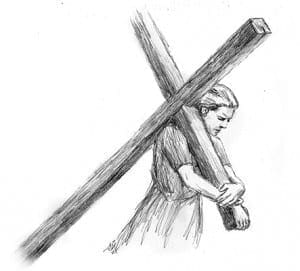The cross of chastity
By LORRAINE V. MURRAY, Commentary | Published June 11, 2015
These are confusing times. Who could have predicted, say 30 years ago, that a hot topic of discussion would involve two men or two women marrying each other? Still, this is where we are today, and many Catholics are uncertain about what our faith teaches. Are we being hateful if we say gay marriage is wrong? Are we supposed to shun people who support it?
If you pick up a copy of “The Catechism of the Catholic Church,” you’ll soon discover that Catholic teaching on homosexuals emphasizes Christ-like love. In fact, the community is called to accept these folks with “respect, compassion, and sensitivity.”
Still, there is a huge difference between accepting people and endorsing their actions. And the catechism also declares homosexual actions to be sinful because they are contrary to natural law and “close the sexual act to the gift of life.”
Keep in mind the catechism is talking about actions, not feelings. A man who feels a sexual attraction to another man doesn’t sin if he refrains from acting on his desires. The sin comes about in the actions.
As for marriage, Catholic teaching firmly defines it in traditional terms. As Archbishop Wilton Gregory eloquently noted in his response to the Supreme Court ruling on the Defense of Marriage Act: “The Catholic Church promotes and defends marriage by teaching about marriage’s authentic meaning as a lifelong, exclusive, and fruitful communion of one man and one woman.”
In his first encyclical letter, “The Light of Faith,” Pope Francis emphasized that marriage is a “sign and presence of God’s own love, and of the acknowledgment … of the goodness of sexual differentiation, whereby spouses can become one flesh (cf. Gen 2:24) and are enabled to give birth to a new life, a manifestation of the Creator’s goodness, wisdom and loving plan.”
So what does the church require of people attracted to members of their own sex? They are asked to make a substantial sacrifice, which is refraining from acting on their sexual desires—and living a chaste life.
This is not an easy road by any means. In truth, it may be a cross—and the catechism emphasizes this by saying that they are called “to fulfill God’s will in their lives, and if they are Christians, to unite to the sacrifice of the Lord’s Cross the difficulties they may encounter from their condition.”
Living a chaste life may seem impossible in a society where provocative images dance before our eyes on websites, in movies and on TV. Still, millions of heterosexuals also live up to this standard, including single people, widows and widowers, and those called to the religious life.
And although we hardly ever see headlines about them, many Catholics with same-sex attraction accept their faith’s teachings and courageously strive to follow them.
For example, blogger Steve Gershom wrote, “Is it hard to be gay and Catholic? Yes, because like everybody, I sometimes want things that are not good for me. The Church doesn’t let me have those things, not because she’s mean, but because she’s a good mother …”
He added, “Show me a religion where you always get to do what you want and I’ll show you a pretty shabby, lazy religion. Something not worth living or dying for, or even getting up in the morning for.”
Being a Catholic, he says, “means believing in a God who literally waits in the chapel for me, hoping I’ll stop by … so he can pour out love and healing on my heart.” He goes on to ask a compelling question: “Which is worth more—all this, or getting to have sex with who I want?”
As Christians, we are expected to pick up our crosses daily and follow Christ. The cross may entail terrible illnesses, bone-crunching poverty and shattering heartbreaks. And no matter what a person’s sexual leanings may be, the cross can also entail saying no to deep-seated desires.
We trust that the sacrifices we make are worth it, since the true goal of our lives is getting to heaven. And how do we get there? By dying to self, confessing our sins, receiving the sacraments, uniting our sacrifices to the Lord’s agonizing cross, helping others carry their crosses—and ultimately by the grace of God.
Lorraine Murray is the author of eight books, most recently “Death Dons a Mask.” Artwork is by Jef Murray. Readers may contact the Murrays at lorrainevmurray@yahoo.com.